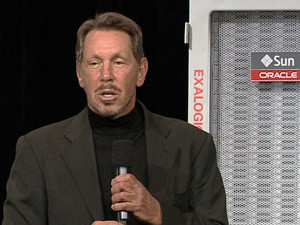
CEO Larry Ellison kicked off Oracle OpenWorld last night, in San Francisco, with a stream of announcements of new products and strategic directions. As expected, cloud services featured heavily in Ellison's keynote, as did database upgrades and storage products.
Oracle's deepening affection for the cloud has culminated in an IaaS (infrastructure as a service) play: the company will build data centres using its own hardware and software stack, and sell capacity to customers in direct competition to the likes of Amazon. The Oracle Public Cloud, first announced in 2011, now offers a full IAAS, PAAS, and SAAS portfolio.
"We didn't decide to get into cloud last year, we did it in 2004 with the Fusion project," Ellison said. "But it took a long time to build a complete suite of cloud apps and the all-important underlying platforms for those applications.
"In our first year of delivering cloud services, we discovered that it wasn't enough simply to be an application provider and platform provider," Ellison said. "People who wanted to take cloud computing seriously, as an alternative to traditional on-premises computing, needed a combination of SaaS and PaaS, but also IaaS."
Private cloud
For customers eager to adopt cloud technologies, but with strategic or regulatory concerns about using public cloud services, Oracle will also provide a private cloud option, using the same stack of hardware and software, owned and managed by Oracle, but deployed on a customer's premises, "inside the firewall", as Ellison described it. Applications and data will be able to move seamlessly between public and private clouds, with the local capacity monitored and over-provisioned to ensure customers have capacity to grow their private cloud on demand.
"While a number of customers are excited about using Oracle's technology in our data centres, some, like many of the banks, would feel more comfortable if those data centres were located behind their firewalls," Ellison said. "They still want true cloud services - they want us to maintain it. So we decided to offer identical infrastructure behind your firewall."
Ellison promised seamless integration between the public and private cloud offerings. "There's no difference: they run identical hardware and software. You can use a private cloud as an extension of Oracle public cloud, moving applications without change from one to the other. You can do development on the Oracle cloud, then run production on your private cloud, or use the public cloud as a standby database for an app in the private cloud. Or as disaster recovery. They are completely interchangeable," he said.
Oracle Database 12c
Ellison also announced Oracle's first major revision to the company's flagship database product in four years. Version 12c (the c refers to "cloud", not a point release) is due for release in 2013. Among its many upgrades is support for multi-tenant databases, with the database management environment capable of hosting, managing, and isolating separate databases for specific applications or customers, with shared hardware resources to improve cost and efficiency.
"This is first multi-tenant database in the world," Ellison said. "Traditionally, SaaS companies have implemented multi tenancy in applications. They invented a layer on top of the Oracle database to allow multiple customers' data to coexist in the same database but did it at the application level.
"Multi tenancy in the application layer is big mistake," Ellison said bluntly. "Though they didn't have much choice." The result was separate databases for each application, with some enterprises having hundreds or even thousands of databases using dedicated hardware.
Oracle Database 12c uses a container database, conceptually similar to server virtualisation, with pluggable databases, which are then granted access to dedicated memory, storage and OS processes.
Although the full details are not yet available, Ellison promised the new database could deliver a service "five times more scalable, on one-sixth the hardware".
Exadata X3
Lastly, Ellison unveiled the new range of Exadata servers. The range is heavily focused on throughput performance, with 22TB of flash cache storage providing major improvements in I/O, at the same price as the previous generation. The range will also include smaller, entry-level configurations.
"The Exadata X3 is designed to store all your databases in memory." Ellison said. "If you thought the old Exadatas were fast, you ain't seen nothing yet."
Coupled with database compression of up to 10x capacity, the Exadata can accommodate 220TB of data in a single rack, Ellison claimed. "You virtually never use disk drives. Everything is in semiconductor memory. Disk drives are becoming pass'e. All active data is migrating off old mechanical rotating disk drives." The flash cache memory is not SSD storage, Ellison adds. "This is not SSD: this is flash as part of the memory hierarchy."
Oracle will use the Exadata systems to provision its cloud services, he added. "If you buy an Oracle Private Cloud, what we install is Exadata X3 and Exalogic."
A new entry-level Exadata unit will be available, with a starting list price of around $200 000, Ellison said.
Many more announcements are expected at the conference. In the opening keynotes, for example, partner Fujitsu and Ellison both hinted at an announcement of research into offloading database processes into silicon for next-generation SPARC processes, promising big improvements in database operations.
Share